Does Recovery Rate of Renal Plasma Flow after Kidney Transplantation Differ in the Choice of Renal Arterial Anastomotic Site?
Toho University, Ota, Japan
Meeting: 2020 American Transplant Congress
Abstract number: D-084
Keywords: Kidney transplantation, Radiologic assessment, Renal function
Session Information
Session Name: Poster Session D: Kidney Technical
Session Type: Poster Session
Date: Saturday, May 30, 2020
Session Time: 3:15pm-4:00pm
 Presentation Time: 3:30pm-4:00pm
Presentation Time: 3:30pm-4:00pm
Location: Virtual
*Purpose: Acquiring better inflow and recovery of blood supply to the renal graft is very critical in clinical kidney transplantation. Whether inflow to the renal graft is different in the choice of arterial anastomotic site in recipients is of great concern. The aim of this study is to evaluate the recovery rate of renal plasma flow by using renal scintigraphy before and after the kidney transplantation and the changes in kidney function in each anastomosis.
*Methods: Among 304 living-related kidney transplant recipients from December 2012 to June 2019 at our institution, we included 100 recipients who were over 20 years old and received kidney allografts with a single renal artery. We compared two phases of effective renal plasma flow (ERPF) of kidney allografts that were measured by renal scintigraphy (99mTc-MAG3) in each donor before transplantation (dERPF) and recipient on the day of transplantation (rERPF), and data were normalized by body surface area. This cohort did not include the recipients with renal scintigraphy of acute tubular injury patterns. The patients were divided into three groups according to the site of the renal arterial anastomosis: Group C, anastomosis to the common iliac artery, 12 cases; Group E, anastomosis to the external iliac artery, 44 cases; and Group I, anastomosis to the internal iliac artery, 44 cases.
*Results: There were no differences in body weight among three groups (analyzed by ANOVA), which reflected no difference in total circulating blood volume in each recipient group. rERPF in each group was not statistically different (ANOVA): Group C vs E vs I, 229.1 ± 93.5 vs 230.5 ± 95.9 vs 241.6 ± 113.6 mL/min, respectively. We defined recovery rate of ERPF in each allograft as the division of rERPF by dERPF (rERPF/dERPF). Comparison of the recovery rate of ERPF in each group was as follows: Group C vs E vs I, 0.79 ± 0.25 vs 0.94 ± 0.36 vs 0.99 ± 0.46, respectively (Fig. 1). This was not statistically different (analyzed by ANOVA). Comparison of the difference between eGFR at 1 year and 1 month after the transplantation ([eGFR 1Y [[Unsupported Character – Symbol Font −]] eGFR 1m]/eGFR 1m) revealed no statistical differences among each group.
*Conclusions: Recovery rate of the renal plasma flow after the kidney transplantation did not differ according to the difference in the arterial anastomotic site in adult recipients. The difference in the choice of the anastomotic site did not affect the changes in kidney function after the transplantation.
To cite this abstract in AMA style:
Yonekura T, Shinoda K, Nishikawa K, Maeda M, Oguchi H, Hidaka Y, Mizutani T, Sakurabayashi K, Muramatsu M, Kawamura T, Sakai K, Shishido S. Does Recovery Rate of Renal Plasma Flow after Kidney Transplantation Differ in the Choice of Renal Arterial Anastomotic Site? [abstract]. Am J Transplant. 2020; 20 (suppl 3). https://atcmeetingabstracts.com/abstract/does-recovery-rate-of-renal-plasma-flow-after-kidney-transplantation-differ-in-the-choice-of-renal-arterial-anastomotic-site/. Accessed January 5, 2026.« Back to 2020 American Transplant Congress

